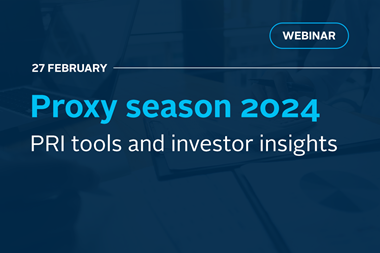Principle 2 encourages PRI signatories to be active owners and incorporate ESG issues into their ownership policies and practices, including engagement with companies and exercise of voting rights. Several PRI signatories have mature practices that offer examples of this. These include activities carried out in-house, on an outsourced basis through investment managers/service providers, or by a combination of internal and external practices.
Active ownership is generally regarded as one of the most effective mechanisms to reduce risks, maximise returns and have a positive impact on society and the environment – for passive and active investors. Divestment alone, alternatively, leaves investors with no voice and no potential to help drive responsible corporate practices. Recent academic research shows the value of active ownership: when done well, engagement and proxy voting activities bring higher financial returns, enhanced communication, improved knowledge, stronger internal relationships and more integrated strategies. Conversely, poor quality dialogue and badly informed proxy voting practices can be harmful and cause cynicism by target companies. Good active ownership requires research, prioritisation, setting objectives, tracking results, integration with investment decision making, persistence, consistency and listening skills.
Asset owners outsourcing activities, partially or entirely, can use this guidance to define their expectations, select third parties and monitor their activities. Investors at the beginning of this journey will not be in a position to cover in detail all areas presented in this guidance. However, they can use the recommendations and examples to set the direction of their active ownership programme and become future leaders.
Developing an active ownership policy
The first step to define an active ownership policy (embedded in the overall investment policy or included in a separate document) is to align it with the organisation’s investment strategy and its overall view on risk, returns and impact on the real economy.
The policy should outline the general approach to active ownership, including alignment with stewardship principles and codes, assets covered, expectations and objectives, the organisational structure and resources dedicated, and conflicts of interest. The engagement section should provide an overview of ESG issues of concern or interest, the due diligence and monitoring process, prioritisation, methods of engagement, escalation strategies and transparency. The proxy voting section would follow a similar structure and add information on decision-making processes, eventual regional practices, filing resolutions, company dialogue pre or post-vote, the securities lending process and transparency.
If an investor decides to outsource active ownership activities to specialised service providers and investment managers, the active ownership policy will have less detail but still be crucial to outline the value of engagement and voting for the organisation and guide the relationship with selected third parties. In this case, the policy will describe the general approach to active ownership and will specify expectations, frameworks of reference, information requirements and monitoring systems.
Engagement practices
The first step to identify targets for engagement is regularly monitoring investee companies on ESG issues which represent value at risk or potential opportunities for long-term financial performance and impact on the real economy. This due diligence phase can partially overlap or coincide with ESG monitoring systems set up to support incorporation practices. The same research used to identify cases of engagement will be continuously integrated with the insights gained during the dialogue with companies following a circular process.
The next stages of an engagement programme entail defining priorities (based on holdings, markets, sectors, ESG benchmarks, themes, etc.), developing objectives and milestones, and tracking results. Investors can also join collaborative engagements but need to define criteria to select the coalitions to participate in. The ingredients for success within a collaborative group are: commonality, coordination, clarity and clout. If initial engagement efforts are unsuccessful, investors can consider escalation strategies such as contacting the board, issuing a public statement, using voting, filing a resolution, seeking legal remedies, and reducing exposure or divesting.
Successful engagement strategy
- Arrive prepared and provide feedback
- Demonstrate a holistic understanding of the company’s performance and strategy
- Understand the corporate culture
- Be sensitive of cultural differences
- Visit site operations
- Praise positive practice
- Focus on the business case and materiality
- Present a consistent and integrated message
- Make connections
- Align requests with international standards, where possible
- Time your requests appropriately
- Share best practices
- Build on and foster ongoing and trustworthy relationships
Proxy voting practices
Engagement and voting practices are interlinked and feed into each other. As investors hold thousands of companies in their portfolios, outsourcing activities to proxy advisors is essential. However, responsible investors do not automatically take on board their voting recommendations and instead make informed decisions based on a triangulation of sources. Such analysis requires time and resources; investors will therefore have to define their criteria for prioritisation. While voting policies can help to guide investors’ decision-making process, research and discretion will always be necessary to ensure meaningful voting. Lead investors would use a combination of internal and external resources and would involve ESG experts as much as portfolio managers. When assessing the quality of ESG resolutions presented at AGMs, investors need to consider: the topic; the invitation for leadership; the evidence; current performance; previous engagement; the tone; the suggested timeline; external pressure; and disclosure requests.
Beyond research and casting votes, voting involves communicating with investee companies before and after the AGM. Where possible, investors should raise concerns with companies before voting against or abstain to initiate dialogue, receive additional information and then start shaping corporate behaviour. When this is not feasible, investors should publicly share the rationale for their votes against management or abstentions and explain their view with interested companies directly either voluntarily or following a company’s request.
Relation to investment decisions
Integrating active ownership practices into investment decisions is one of the most difficult but necessary tasks to achieve a holistic investment strategy.
Best practice to link active ownership to investment decision making includes:
- ensuring regular cross-team meetings and presentations;
- sharing active ownership data across platforms that is accessible to ESG and investment teams;
- encouraging ESG and investment teams to join engagement meetings and roadshows;
- delegating some engagement dialogue to portfolio managers;
- involving portfolio managers when defining an engagement programme and developing voting decisions;
- establishing mechanisms to rebalance portfolio holdings based on levels of interaction and outcomes of engagements and voting; and
- considering active ownership as a mechanism to assess potential future investments.
Assessing external managers and service providers
When investors decide to partially or fully outsource their active ownership activities to investment managers or specialised service providers, defining criteria to select, appoint and monitor third parties is crucial. In the reviewing phase, an investor needs to evaluate the third party’s active ownership policy, capacity and governance, engagement process and outcomes, investment decision-making process and reporting capacity. An evaluation of investment managers’ and service providers’ active ownership practices can be made through regular reporting, meetings and surveys/questionnaires. They should focus, among other areas, on: the depth and breadth of internal and external ESG research used; controversial or material ESG topics raised/to be raised during engagement dialogue or considered/to be considered during the voting season; the rationale for engagement discussions and voting decisions, and alignment or deviation from the investor’s investment beliefs/strategy and agreed policies of reference; and the objectives, progress, outcomes and next steps of specific engagements.
Disclosure
As much as investors are engaging with companies to access and encourage better ESG information and practices, they are responsible for reporting to their clients and beneficiaries on their engagement and voting activities and relevant outcomes. Such information should be easy to access and understand, and provided on a regular basis (i.e. quarterly or annually).
Best practice disclosure on engagement activities include:
- a presentation of the overall engagement strategy, due diligence and monitoring approach;
- detail on the selection of engagement cases and definition of objectives;
- number of engagements undertaken;
- breakdown of engagements by type/topic;
- breakdown of engagements by region;
- an assessment of progress and outcomes achieved against defined objectives;
- examples of engagement cases with specific companies (when the information is not considered sensitive and confidential);
- detail on eventual escalation strategies taken after the initial dialogue has been unsuccessful (i.e. filing resolutions, issuing a statement, voting against, divestment etc.); and
- whether the information provided has been assured externally.
Good quality reporting on voting activities covers:
- all voting decisions, including on ESG resolutions;
- number of votes cast and corresponding AGMs covered across markets and percentage of total available votes;
- an overview of topics covered during the voting season;
- percentage of votes cast for, against or abstained;
- explanation of the rationale for voting against management or abstentions; and
- whether the information provided has been assured externally.
While this guidance focuses on practices related to listed equity holdings, several insights and recommendations on policy development, execution and disclosure can be equally applied to other asset classes such as corporate fixed income and private equity. Further in-depth analysis of the differences and engagement implications in fixed income is included in the forthcoming PRI publication, ESG engagement for fixed income investors: managing risks, enhancing returns.
Downloads
A practical guide to active ownership in listed equity
PDF, Size 1.08 mbGuia prático de titularidade ativa em renda variável listada em bolsa
PDF, Size 1.26 mb상장 기업을 대상으로 하는 적극적 주주권 행사에 관한 실전 가이드
PDF, Size 1.73 mbGuide pratique pour l’actionnariat actif dans les sociétés cotées
PDF, Size 2.18 mb股票积极所有权实践指南
PDF, Size 3.81 mb
A practical guide to active ownership in listed equity
- 1
 Currently reading
Currently readingExecutive summary
- 2
- 3
- 4
- 5
- 6




















